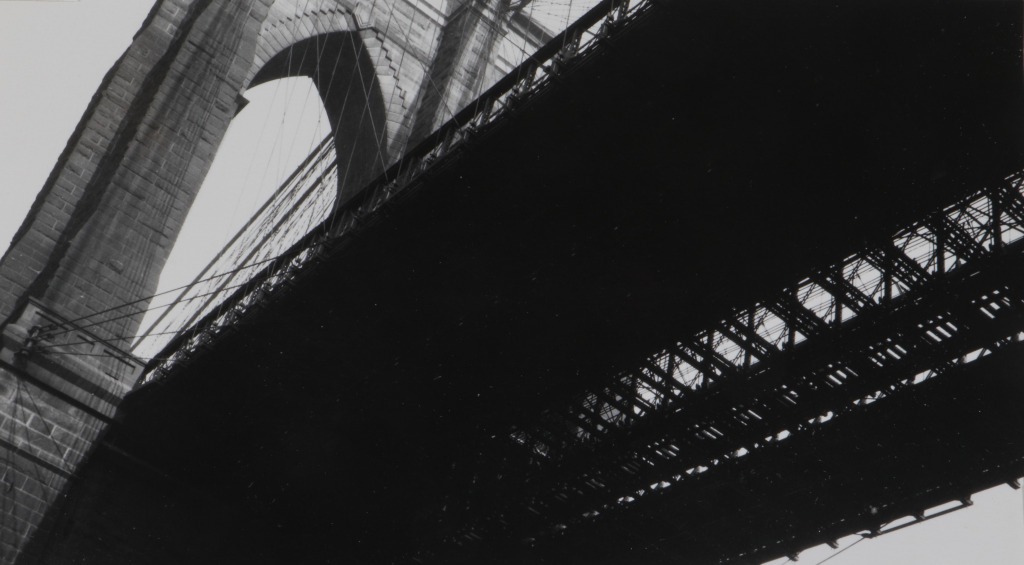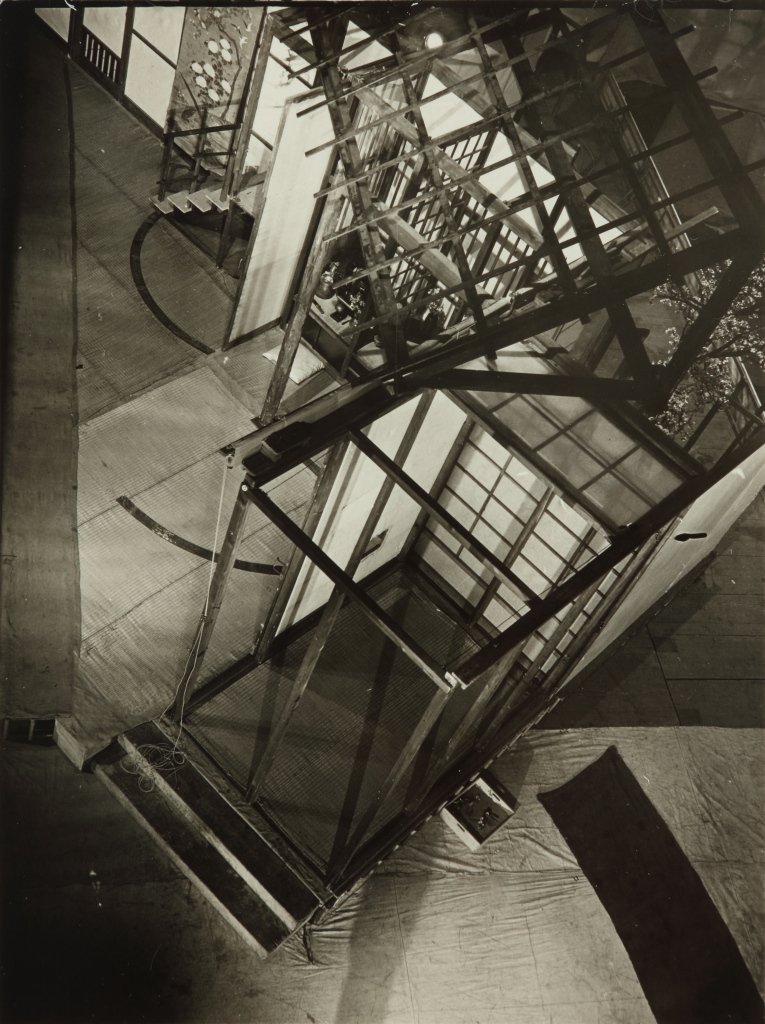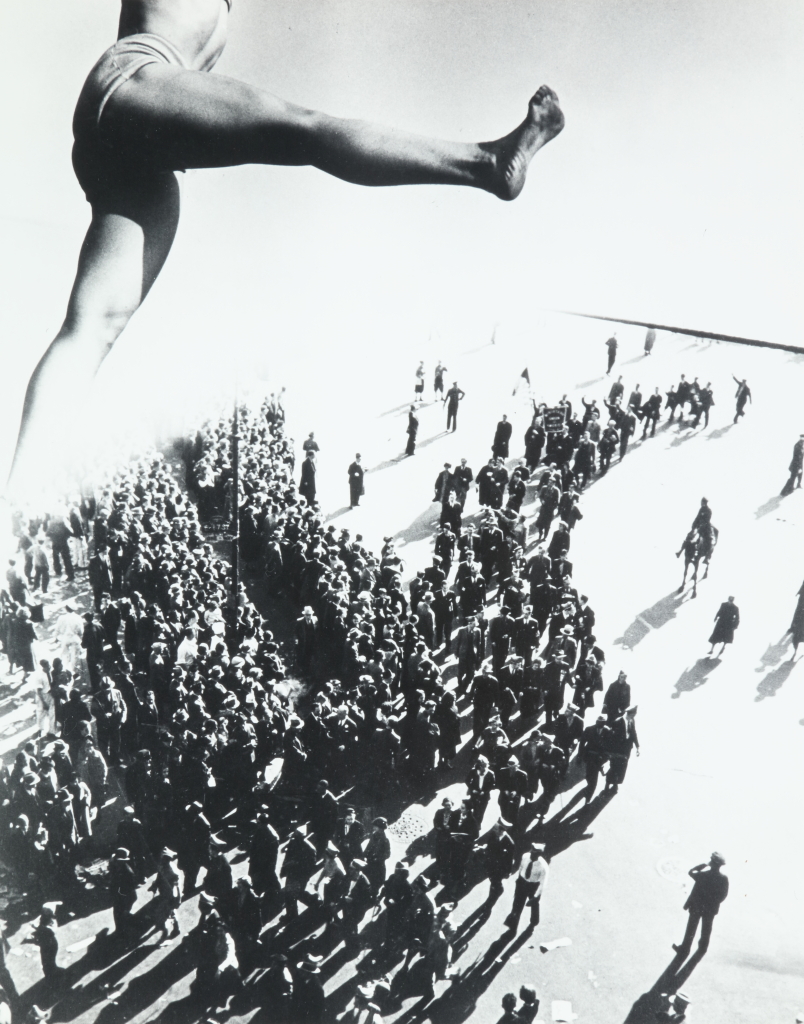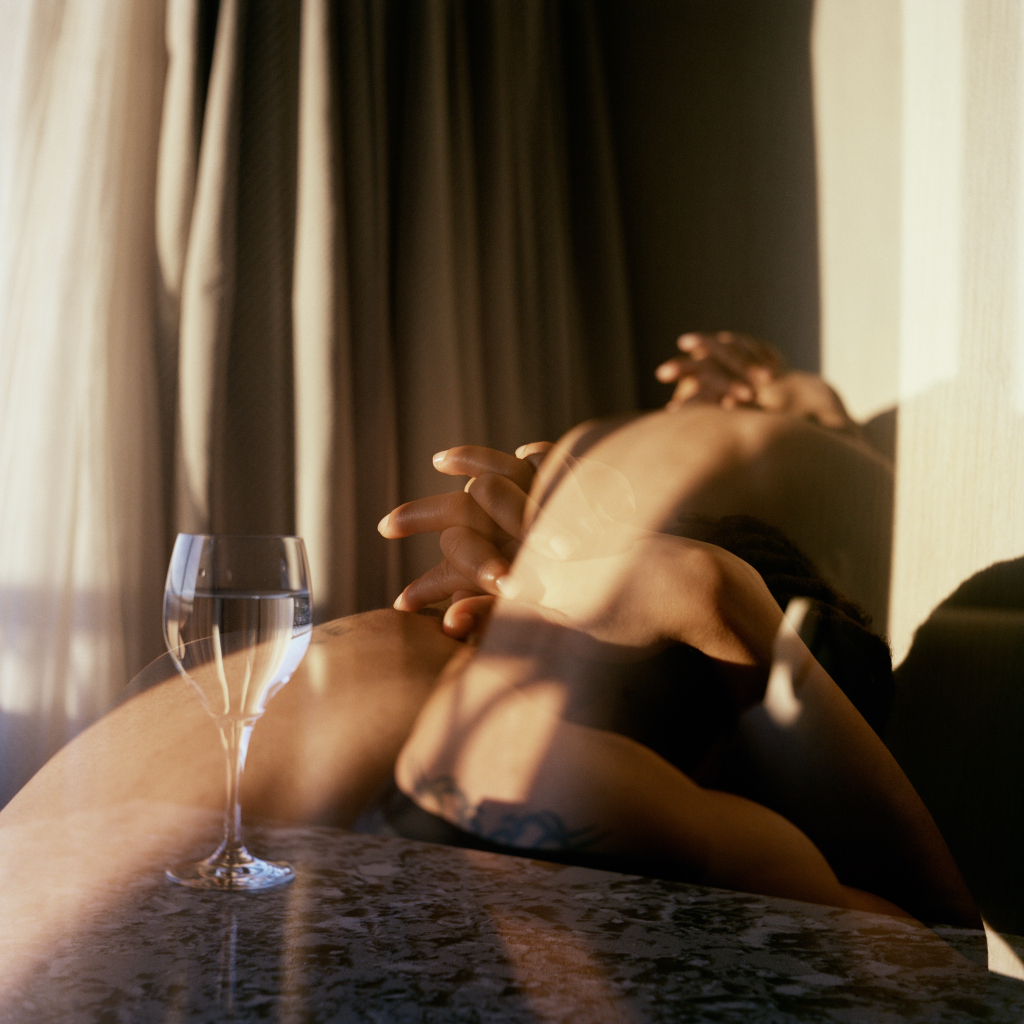—László Moholy-Nagy, 1928
Photography's New Vision: Experiments in Seeing
June 13, 2025 – January 4, 2026
Tickets
Buy NowMembers and Museum Pass: Free
Not-Yet-Members: $23.50
The New Vision movement of the 1920s and 1930s offered a revolutionary approach to seeing the world. It represented a rebellion against traditional photographic methods and an embrace of avant-garde experimentation and innovative techniques. László Moholy-Nagy, an artist and influential teacher at the Bauhaus in Germany, named this period of expansion the “New Vision.” Today, the term encompasses photographic developments that took place between the two World Wars in Europe, America, and beyond. New Vision photographers foregrounded inventive techniques, including photograms, photomontages, and light studies, and made
photographs that favored extreme angles and unusual viewpoints. These approaches—which also extended to more defined movements like Surrealism—spoke to a desire to find and see different perspectives in the wake of World War I.
Uniting more than one hundred works from the High’s photography collection, the exhibition traces the movement’s impact, from its origins in the 1920s to today, and demonstrates its long-standing effect on subsequent generations.
Agave Design I, ca. 1920
Imogen Cunningham
American, 1883–1976
Agave Design I, ca. 1920
Gelatin silver print
Purchase with funds from Georgia-Pacific Corporation, 1987.138

Men’s Fashions, 1925, printed 1956
Eugène Atget was the great chronicler of Paris at the turn of the century. His vast photographic archive captures a city on the precipice of modernization. Though his photographs of empty city streets were documentary in nature, the Surrealists admired their dreamlike quality and claimed Atget as one of their own despite his protestations. They believed any photograph could shed its original context and intent when viewed with a surrealist sensibility. Atget’s photograph of mannequins peering out of a shop window appealed to the movement by embodying the uncanny valley, where the human likeness of a nonhuman entity evokes both affinity and discomfort in viewers.
Eugène Atget
French, 1857–1927
Men’s Fashions, 1925, printed 1956
Gelatin silver print
Purchase, 74.163 C

Sbor na demonstratsia (Gathering for a Demonstration), 1928, printed 1970s
Alexander Rodchenko was a key figure in the movements of New Vision and Constructivism—abstract and functional art that reflected an industrial society. Advocating “to achieve a revolution in our visual thought,” he explored various methods, such as photographing from unexpected angles, to capture dynamic views and expose new realities. With a new, lightweight 35 mm camera, he often photographed from his apartment balcony to create dramatic scenes of the street below. The perspective in this photograph flattens the building’s stories into one visual field, giving the image a theatrical quality as an onlooker peers over the railing.
Alexander Rodchenko
Russian, 1891–1956
Sbor na demonstratsia (Gathering for a Demonstration), 1928, printed 1970s
Gelatin silver print
Gift of Joseph and Yolandra Alexander, 2012.423

The Bridge, 1929
A central figure among twentieth-century American photographers, Walker Evans created works in his early career that sample from the New Vision aesthetic, which he may have encountered while abroad in Paris in 1926. His photographs of New York City, made after he returned to the United States, feature dramatically angled or cropped scenes of architecture and city life. Evans made numerous photographic studies of the Brooklyn Bridge from both below and on the bridge, portraying it less as a recognizable landmark and more as a hulking expanse whose form fills each tight frame.
Walker Evans
American, 1903–1975
The Bridge, 1929
Gelatin silver print
Gift of Arnold H. Crane, 73.72 F

Stage Set for “Madame Butterfly,” 1931
Moholy-Nagy, a leader of the New Vision, had an expansive artistic practice that included painting, photography, sculpture, film, and more. As a teacher at the Bauhaus, which connected art and industry, he believed in technology’s potential to advance art and society. In 1929, he became set designer at the Kroll Opera House and created avant-garde sets with translucent and perforated materials, often making light itself a sculptural element. Lucia Moholy, a photographer, writer, teacher, and Moholy-Nagy’s first wife, was commissioned as Kroll’s stage photographer. In this image, which either artist may have made, the sharp angle shot from above complicates the set of Madame Butterfly, emphasizing intersecting, moving elements and heightening areas of light and shadow.
László Moholy-Nagy
Hungarian, 1895–1946
Lucia Moholy
British, born Czechoslovakia, 1894–1989
Stage Set for “Madame Butterfly,” 1931
Gelatin silver print
Purchase with funds from Georgia-Pacific Corporation, 1984.227

Composition, 1932, printed 1974
Florence Henri is well known for her manipulations of light and form that create complex, surrealist scenes. She used angled mirrors to frame, obscure, and replicate portions of scenes to dissolve a sense of perspective and space, as seen in this still life comprising mirrors, pears, and an image of the sea. After only one semester studying under László Moholy-Nagy at the Bauhaus in 1927, Henri shifted her focus from painting to photography and began using various experimental techniques such as photomontage, multiple exposures, photograms, and negative printing.
Florence Henri
American, born Switzerland, 1893–1982
Composition, 1932, printed 1974
Gelatin silver print
Gift of Dr. Joe B. Massey in honor of Maria L. Kelly, 2024.50

Protest, 1940
Barbara Morgan
American, 1900–1992
Protest, 1940
Gelatin silver print
Purchase, 1987.39

Pleasures and Terrors of Levitation #37, 1953
Aaron Siskind was recognized for the ways he rendered his surroundings into often stark shapes and forms, which reflected his fascination with contemporary trends in abstract art. He was an influential teacher at Chicago’s Institute of Design, which was founded by László Moholy-Nagy as the New Bauhaus. This image of a person flying or falling comes from a series Siskind made of the contorted bodies of divers plunging into Lake Michigan. He masterfully created its disorienting effect through tight focus on the floating figure without contextual elements.
Aaron Siskind
American, 1903–1991
Pleasures and Terrors of Levitation #37, 1953
Gelatin silver print
Gift of Adair and Joe B. Massey in honor of Gus Kayafas, 2000.234

Construct NYC, 1984
Barbara Kasten’s art is as much about the process of setting up innovative still life scenes as it is about the photographs she makes of them. Her Constructs series focuses on large-scale complex assemblages that she builds in her studio using a wide variety of materials, including painted wood, plaster, mirrors, screens, and fibers. Her work is not digitally altered; instead, she complicates the scene using mirrors and light, much in the tradition of Florence Henri, whose photograph is also on view in the exhibition.
Barbara Kasten
American, born 1936
Construct NYC, 1984
Dye destruction print
Gift of Lucinda W. Bunnen for the Bunnen Collection, 2012.611

Esme Swimming, Parkroyal on Pickering, Singapore, 2014
Expanding on the New Vision precedent of disorienting aerial photography, Lucas Foglia photographs from a balcony at an acrophobia-inducing angle. The central figure floats in a pool far below within 160,000 square feet of plantings in an urban hotel complex. While emulating the spirit of an untamed rainforest canopy, this view is interrupted by the crowded five-lane street below and the swaths of glass-and-concrete architecture. Foglia’s Human Nature series explores humanity’s attempts to control and curtail nature while also seeking solace and wildness through it.
Lucas Foglia
American, born 1983
Esme Swimming, Parkroyal on Pickering, Singapore, 2014
Pigmented inkjet print
Gift of Irene Zhou, 2020.152

Lightning Fields 182, 2009
Inspired by William Henry Fox Talbot, an inventor of photography who was fascinated with electromagnetic conduction, Hiroshi Sugimoto began applying charges of electricity directly to unexposed photographic film. After months of honing his technique in the darkroom, he managed to achieve remarkable results with a handheld wand charged by a generator. His Lightning Fields photographs are made without a camera or lens. Here, the abstract visual trace of an electric charge measuring over 400,000 volts sweeps across the composition, reading like the textures of a human hand, the upward tentacles of a fern, or the stark branches of a tree.
Hiroshi Sugimoto
Japanese, born 1948
Lightning Fields 182, 2009
Gelatin silver print
Purchase through funds provided by patrons of Collectors Evening 2012, 2012.3

Calaeno, 2018
V. Elizabeth Turk is an Atlanta-based photographer whose work explores the connections between the human body and the natural world. To make this print, Turk used an analog process from the 1800s that involves coating a large sheet of paper with light-sensitive chemicals. She then arranged her model on top of the sheet and exposed it to light, creating a ghostly silhouette, before repeating the exposure with plants. The resulting photogram is a unique image in which botanical forms intersect with the body, alluding to bones, veins, and skin and suggesting a visceral bond between humans and the environment.
V. Elizabeth Turk
American, born 1945
Calaeno, 2018
Van Dyke print
Purchase with funds from Lucinda W. Bunnen for the Bunnen Collection, 2019.182

Phoenix V, 2021
Noémie Goudal visualizes “deep time” (geological history of the planet) and paleoclimatology (study of past climates) to challenge our perception of the world. Referring to the ancient continental split two billion years ago that formed South America and Africa, this image features the Phoenix atlantica, a palm tree that grows on both sides of the Atlantic. Goudal arranged strips of photographic prints of the palms made on one continent in front of the physical palms on the other and rephotographed the scene. The resulting image interweaves the two continents, creating a glitchy, kaleidoscopic view meant to unsettle our sense of stability and the constancy of the planet.
Noémie Goudal
French, born 1984
Phoenix V, 2021
Dye coupler print
Purchase through funds provided by patrons of Collectors Evening 2023, 2023.360

It Lingers Sweet, 2022
Naima Green’s practice centers connection and collaboration to cast a tender lens on her own queer community of color. Her lyrical portraits take shape in intimate domestic spaces and airy outdoor environments that embody havens for the people in those spaces. Through double exposure and serial photographs, she provides what she calls “multiple entry points” into a moment in time, translating movements and emotions into a single image. She explains her interest in double exposure “as a means of capturing things that can’t be held in just one way . . . ,” allowing her to “play with loosening the narrative and letting go of some control.”
Naima Green
American, born 1990
It Lingers Sweet, 2022
Pigmented inkjet print
Purchase with funds from the LGBTQIA+ Photography Centennial Initiative, 2024.70

In the Press
Musée Magazine | “Photography’s New Vision: Experiments in Seeing | High Museum of Art”
This exhibition is organized by the High Museum of Art, Atlanta.
Premier Exhibition Series Sponsor

Premier Exhibition Series Supporters

Benefactor Exhibition Series Supporters
Robin and Hilton Howell
Ambassador Exhibition Series Supporters
Mrs. Harriet H. Warren
Contributing Exhibition Series Supporters
Farideh and Al Azadi
Mary and Neil Johnson
Mr. and Mrs. Baxter Jones
Megan and Garrett Langley
Margot and Danny McCaul
Wade A. Rakes II and Nicholas Miller
Generous support is also provided by
Alfred and Adele Davis Exhibition Endowment Fund, Anne Cox Chambers Exhibition Fund, Barbara Stewart Exhibition Fund, Dorothy Smith Hopkins Exhibition Endowment Fund, Eleanor McDonald Storza Exhibition Endowment Fund, The Fay and Barrett Howell Exhibition Fund, Forward Arts Foundation Exhibition Endowment Fund, Helen S. Lanier Endowment Fund, John H. and Wilhelmina D. Harland Exhibition Endowment Fund, Katherine Murphy Riley Special Exhibition Endowment Fund, Margaretta Taylor Exhibition Fund, RJR Nabisco Exhibition Endowment Fund, and USI Insurance Services.